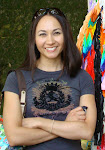We tried to make the most out of our last day in Kyoto by visiting a variety of temples. We rode the JR Sagano Line to the Hanazono Station and began our journey...
Our first stop was Myoshin-ji, a walled-off complex of temples and subtemples.
Tall Ken!
Ninna-ji, a UNESCO World Cultural Heritage Site, was built in 888. It was formerly called the Old Imperial Palace of Omuro as it served as a residence for the ex-emperor. The temple is now noted as the headquarters of Omuro School of the Shingon Sect of Buddhism.
Five-story pagoda from the 17th century.
Ryoan-ji is home to a simple rock garden, which is acknowledged to be one of the masterpieces of Japanese culture. The rock garden was said to be created at the end of the 15th century during the Muromachi Period by a highly respected Zen monk, Tokuho Zenketsu.
The rock garden, consisting only of white gravel and fifteen rocks, is Japan's most famous hira-niwa (a flat garden void of hills or ponds). The rock garden is surrounded by low earthen walls made of clay boiled in oil.
After meditating at the rock garden we cooled off by eating some vanilla and green-tea ice cream; it was actually very tasty!
Kinkaku (Golden Pavilion), also known as Rokuon-ji, is a three-story pavilion covered in bright gold leaf and features a bronze phoenix on top of the roof.
The building consists of three types of architecture. The 1st floor is Shinden-zukuri, palace style; the 2nd floor is Buke-zukuri, samurai house style; the 3rd floor is Karayo style, Zen temple style.
After viewing the temple and the gardens, the rain started to pour down. Already somewhat drenched, we hailed a taxi and rode the rest of the way to the train station.
In the evening we visited the Gion District, the famous entertainment and geisha quarter on the eastern bank of the Kamo-gawa. Unfortunately we didn't see any geisha.
Interesting advertising in a storefront.
The night was pleasant and I was able to take some night photographs of the Kamo-gawa.































































